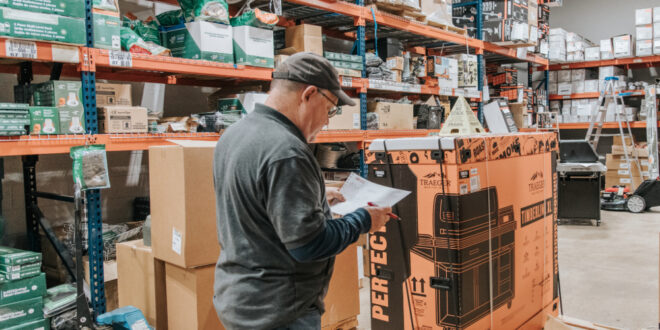Headline after headline warns of the impending impact of global economic shifts, tariffs and other supply chain challenges on retailers. To better understand the realities of what’s happening in the hardlines supply chain and how retailers can best prepare for any market uncertainties, three members of Orgill’s executive team shared their insights with Hardware Retailing.
 Hardware Retailing (HR): What guidance would you give to retailers with all the news about tariffs and their potential impact on sales and operations?
Hardware Retailing (HR): What guidance would you give to retailers with all the news about tariffs and their potential impact on sales and operations?
David Mobley, Orgill executive vice president of sales (DM): First off, I’d say don’t panic, but be prepared. Tariffs may or may not hit in a big way, but either way, retailers need to have a robust process for both staying on top of how the market is shifting and then handling price changes in a timely and effective way. That’s absolutely critical. The days of slowly updating tags around the store are over. You’ve got to respond fast and accurately to protect margins.
HR: How can retailers stay on top of a rapidly shifting market?
DM: For most retailers, I would suggest making sure you stay in regular contact with your distributor’s sales representatives and merchandising team, as well as any vendors you might deal with directly. These are all resources for you, and they offer you another set of eyes and ears that may be one step closer to recognizing and identifying market shifts.
Our directive to our sales team is to be consultative with their customers. This means helping them identify potential issues and develop solutions that will best suit their business, so our team is very responsive to issues like price changes and can help any retailer better navigate this landscape. For example, if a product like an air compressor from China suddenly has a 145% tariff, our team can advise you as to whether you should stick with it or look at alternatives from countries like Vietnam. This is one example of how our team helps retailers find those alternatives quickly.
HR: How does a retailer build a plan for handling a higher volume of price changes?
DM: A good part of being prepared to deal with a higher volume of price changes is to have a plan in place at the store level. If you are used to having one employee process price changes and that system is built around a regular volume of changes, this might not be adequate if that volume increases to three or four times what’s typical. In addition to an internal system, another one of the first things retailers should do is to take advantage of whatever tools they have at their disposal that might make this process easier. Again, this is all about utilizing any resources you have to get better information.
HR: Supply chain challenges during the pandemic, including price changes and scarcity of product, created concerns for retailers. Do you see this as a similar situation?
DM: There are some similarities, but it is also very different. One thing we all learned during those times is that you need to be agile. I wouldn’t encourage anyone to do any panic buying across the board or anything like that, because what if you stock up right now and then the tariffs don’t materialize? Are you then stuck with a lot of products when the prices might go down?
I would advise retailers to be opportunistic, not overzealous. If there are strong buying opportunities for essential products that sell consistently, it might make sense to buy ahead. Still, stay nimble.
HR: Should retailers look at promotional buying opportunities any differently when there are looming tariffs?
DM: Promotional buying is another area where we’ve shifted at Orgill, and we think the strategy we are taking will be particularly helpful in today’s markets. Traditionally, promotional buying for most retailers would be focused on two times a year, fall markets and spring markets. But instead of forcing retailers into this pattern that isn’t the most conducive to the way they do business, we switched to multiple buying events each year that are more in line with the
seasonal retail patterns.
We offer four seasonal promotional buying events and because we have this increased frequency, it doesn’t create a “pig into a python” scenario where retailers are forced to order more product than they might need because of limited opportunities. We think our buying cadence reduces risk, aligns closer to actual sales cycles and gives better terms and discounts. It’s a more measured, modern approach.
HR: How important is it right now that retailers have a solid relationship with their suppliers?
DM: It’s huge. It’s always huge, but right now, retailers need to know their distributor is vetting price increases and not just passing them along. We work to validate every change in the market before pushing it to our partners. We don’t claim to know everything, but we’re transparent about what we do know.
 HR: From your perspective, what’s the most important thing retailers should be doing right now?
HR: From your perspective, what’s the most important thing retailers should be doing right now?
John Dillon, Orgill senior vice president of pricing (JD): I would have to support what David mentioned, the biggest thing is having a disciplined process in place for implementing price changes. Tariffs create a resource strain, and you can’t rely on one person doing manual updates. Retailers need to have a scalable system to manage those changes rapidly and consistently.
HR: From your position on the pricing side, how does Orgill approach supplier cost increases caused by tariffs?
JD: We treat tariff-related increases the same as any cost change—whether it’s due to labor, materials or transportation. We vet the increases and do our research to ensure we’re not putting our customers at a competitive disadvantage with either the price we charge them for the product or the prices we are suggesting they charge the customers in their trading area. But this isn’t really any different than how we normally manage our pricing.
For pricing, we start at retail and look at what competitors are doing and then we use that information to establish pricing suggestions for our customers. Then, we work backward from that to arrive at our overall pricing. Making sure they can be competitive and profitable is at the heart of the entire process.
HR: When you are seeing a high volume of price changes at the distribution level, how do you manage to push those out without overwhelming the retailers?
JD: We are definitely conscious of the fact that we can’t just swamp retailers with endless updates. Even if the market validates the increase, we still try not to overwhelm retailers with hundreds or thousands of SKUs changing at once. With some big lines or high SKUs count, it’s unavoidable, but we do our best to meter them out.
HR: Orgill uses a multi-tiered pricing matrix to help retailers with their variable pricing. Do rapid swings in costs or potential tariffs have an outsized impact on how this matrix works?
JD: Well, one thing that we think puts us at an advantage with the way we validate our retail pricing suggestions is that we closely monitor prices from competitors. Not only does this allow us to help our customers accurately price their inventories for maximum margin opportunities, it also allows us to look at that data and factor that into our conversations with vendors basically pushing back on any increases where we don’t see market validation.
HR: Do you feel this kind of information helps Orgill’s relationship with vendors?
JD: We feel that the strong relationships we have with our vendor partners are extremely helpful in these kinds of environments. We are very transparent with them, and they are very transparent with us. We’ve tracked every cost increase attributed to tariffs, and when tariffs are rolled back or expire, we know who to go back to for potential reductions. We did that successfully during the last round of tariff adjustments and we will continue to do this.
 HR: From Orgill’s perspective, what are you doing internally to prepare for and potentially mitigate any tariff-related impacts?
HR: From Orgill’s perspective, what are you doing internally to prepare for and potentially mitigate any tariff-related impacts?
Clay Jackson, Orgill executive vice president and chief operating officer (CJ): We’re approaching it from two angles: how we are managing our Exclusively Orgill (private-label) brands and how we are managing the relationships we have with independently branded vendors.
For the private-label side, we’ve already made significant shifts. About 50% of that product is no longer sourced from China, and we’re planning to get that down to 25% by year-end. We’re also exploring alternative sourcing opportunities across multiple countries and working closely with our factories and sourcing agents to identify efficiencies and share the fiscal responsibility—rather than pushing all the costs onto the retailer or eating them ourselves.
When it comes to how we are working to mitigate the impact of tariffs with our independently branded vendor partners, we are leaning into our relationship with them. It’s all about collaboration. When vendors bring cost increases, we ask them to walk our category management team through the specific SKUs, materials and country-of-origin details. That gives us a transparent look at what’s changing and why. Then we can work with them on sourcing alternatives, operational synergies or—when necessary—reassort the line altogether.
HR: What about some categories or product lines that are primarily sourced from areas like China, where opportunities to move production may be more challenging?
CJ: Holiday is a perfect example—80 to 90% of these products still come from China. You can’t just move that production overnight, if at all. For those critical programs, the programs that are pre-booked well in advance, we will of course, honor our commitments to customers on prices. If a customer booked at a spring market price, we’ll eat the incremental cost if necessary. That’s part of being a reliable partner.
HR: Are you seeing risks of product shortages as the year progresses?
CJ: It certainly could happen but it’s not like what we saw coming out of the pandemic. What we might end up seeing is more about bottlenecks in the supply chain as opposed to raw shortages. It’s also important to note that if the impact of tariffs isn’t as great as some might say or if the tariffs ease and the market rebounds quickly, we could go from pause to full steam ahead pretty quickly.
That surge in demand might strain factories, ports and logistics infrastructure and that might be more like we saw post-COVID. But one big difference is that we are watching closely and monitoring the situation. We have the knowledge we gained during the pandemic and we can likely work around the kinds of strains we experienced back then.
HR: We have seen some messaging promoting a “buy now before the tariffs hit” strategy. What is Orgill’s approach?
CJ: We’re not trying to create a run on the bank. Our philosophy is to consult, not panic. We’re working with dealers to identify where promotional or preemptive buys make sense, but not just saying, “Buy truckloads now or miss out.” That’s not helpful long-term. And this is another area where we feel that we are at a bit of an advantage. As David said, we have a large, mobilized and consultative sales force that is working with retailers on a daily basis to help them navigate this kind of situation and understand what’s really happening on the ground.
HR: So what are some of the advantages that you think Orgill offers in situations like this?
CJ: I see three main tailwinds. First, we are nimble—our volumes are large enough to matter but small enough to pivot. Second, with 80,000 SKUs, we offer plenty of opportunities for item substitution and transferability to products and assortments that aren’t as deeply impacted by tariffs. And third, we’ve proactively invested in inventory—running about $100 million higher than normal—to maintain high service levels and buffer against tariff-driven disruptions.
HR: Is there any other advice that you would pass along to retailers?
CJ: Stay informed. Use reporting tools like Orgill’s PREP program or whatever tools your distributor, vendor partners or your POS partners might make available to you. But also, you can’t forget that you still need to focus on the in-store experience. In uncertain times, retailers can win by offering excellent customer service and personalization. That still matters—and sometimes it matters more than price alone.[/vc_column_text][/vc_column][/vc_row]
 Hardware Retailing The Industry's Source for Insights and Information
Hardware Retailing The Industry's Source for Insights and Information






